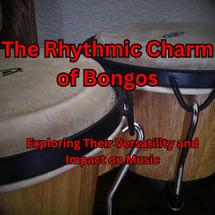Posted by Kopf Percussion Staff on 18th Aug 2024
The Rhythmic Charm of Bongos: Exploring Their Versatility and Impact on Music
As the owner of Kopf Percussion, I’ve always been fascinated by the diverse world of percussion instruments. Among the many instruments that have captured the hearts of musicians worldwide, bongos hold a special place. These small, yet powerful, drums have a rich history and a vibrant sound that makes them an essential part of various musical genres, particularly in Latin music. In this blog post, I’ll explore the origins, construction, and versatility of bongos, and provide some insights into why they are a must-have for any percussionist. Whether you’re a seasoned musician or just starting out, bongos offer a unique rhythmic charm that’s hard to resist.
The Origins of Bongos
Bongos are a pair of small, open-bottomed drums that are connected together and played with the hands. They originated in Cuba in the late 19th century, evolving from traditional African drums brought to the Caribbean by enslaved Africans. Over time, bongos became an integral part of Cuban music, especially in genres like son, salsa, and Afro-Cuban jazz. The distinct high-pitched sound of bongos adds a lively, upbeat element to these musical styles, making them indispensable in Latin percussion.
The two drums in a bongo set are of different sizes: the larger drum, known as the "hembra" (female), and the smaller drum, called the "macho" (male). This size difference allows for a range of tones, with the hembra producing a deeper sound and the macho creating a sharper, higher-pitched tone.

Construction and Materials of Bongos
The construction of bongos is a key factor in their sound and durability. Traditionally, bongos are made with wooden shells, often from hardwoods like oak, hickory, or mahogany. The drumheads were originally made from animal skins, such as goat or cowhide, which are known for their warm, resonant tones. Modern bongos, however, often use synthetic materials for the drumheads, offering increased durability and resistance to environmental changes.
The hardware that connects the two drums is typically made of metal and includes tuning lugs that allow players to adjust the tension of the drumheads. This tuning capability is essential for achieving the desired pitch and tone, making bongos a versatile instrument that can adapt to different musical contexts.
The size of the bongo drums can also vary, but the most common sizes are 7 to 8 inches for the macho and 8.5 to 9 inches for the hembra. These dimensions provide a good balance between portability and sound quality, allowing the drums to produce a wide range of tones that can cut through the mix in both live and recorded settings.
Techniques for Playing Bongos
Playing bongos involves a combination of hand techniques that create different sounds and rhythms. Here are a few basic techniques that every bongo player should know:
1. Open Tone: This is the most common sound produced on bongos. To create an open tone, strike the drumhead near the edge with the pads of your fingers. This technique produces a resonant, full-bodied sound that is essential for playing melodies and rhythmic patterns.
2. Slap Tone: The slap tone is a sharper, more percussive sound that is produced by striking the drumhead with the flat part of your fingers. This technique adds accents and dynamics to your playing, making it a crucial element in more complex rhythms.
3. Muffled Tone: To create a muffled tone, press your fingers lightly against the drumhead immediately after striking it. This technique dampens the sound, creating a staccato effect that is useful for adding texture and variation to your rhythms.
4. Heel-Tip Technique: This technique involves alternating between striking the drumhead with the heel of your hand and the tips of your fingers. The heel-tip technique is commonly used in traditional Cuban rhythms, creating a rolling, continuous sound that drives the music forward.
For those interested in mastering bongo techniques, this bongo course offers a comprehensive guide to developing your skills. It covers everything from basic techniques to advanced rhythms, making it an invaluable resource for both beginners and experienced players.
The Versatility of Bongos in Different Musical Genres
While bongos are most closely associated with Latin music, their versatility makes them a valuable addition to a wide range of musical genres. In jazz, bongos are often used to add rhythmic complexity and a lively, improvisational feel. In pop and rock music, they can provide an interesting percussive layer that enhances the overall groove. Even in more traditional settings, such as folk or acoustic performances, bongos can add a unique rhythmic flavor that sets the music apart.
One of the reasons bongos are so versatile is their ability to produce a wide range of tones and dynamics. By adjusting the tension of the drumheads and using different playing techniques, you can create a variety of sounds that fit the specific needs of your music. Whether you’re playing soft, subtle patterns in an intimate acoustic set or driving a fast-paced salsa rhythm on a lively dance floor, bongos offer the flexibility to adapt to any situation.
For those who are already familiar with other percussion instruments like the cajon, adding bongos to your setup can greatly expand your rhythmic capabilities. The combination of cajon and bongos can create a rich, layered sound that’s perfect for a wide range of musical styles.
Conclusion: Why Bongos Should Be Part of Your Percussion Setup
Bongos are more than just a pair of small drums; they are a gateway to a world of rhythm and expression. Their rich history, versatile sound, and accessible playing techniques make them an essential instrument for any percussionist. Whether you’re a beginner looking to start your percussion journey or an experienced player seeking to expand your sound, bongos offer endless possibilities for musical exploration.
At Kopf Percussion, I’m passionate about all aspects of percussion, and I’m always excited to share my knowledge and experience with fellow musicians. Whether you’re exploring bongos, cajons, or any other percussion instrument, there’s always something new to discover. Keep exploring, keep playing, and keep the rhythm alive!


